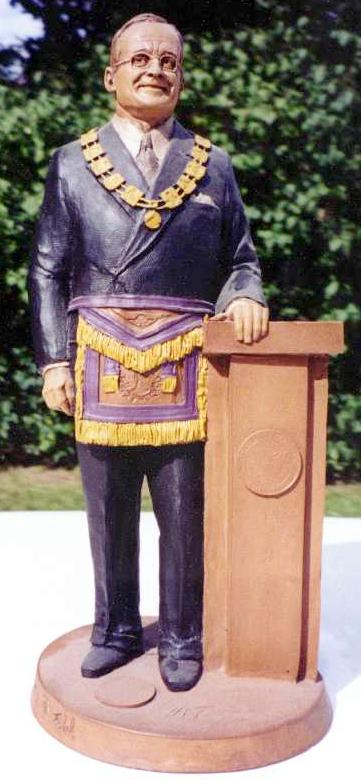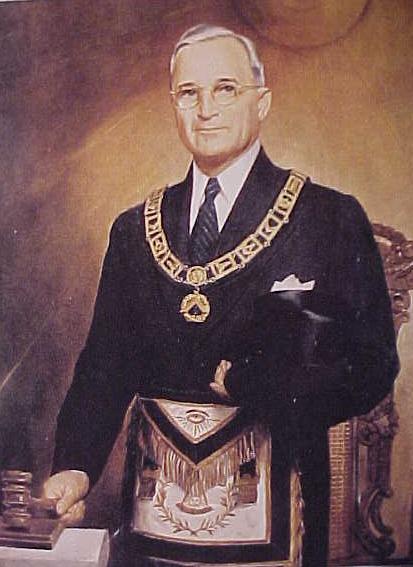Harry
S Truman Sculpture
by
Artist Tom Clark

Here
is a wonderful statue created by artist Tom Clark depicting one of America's
most famous Masons and President Harry S Truman. He is dressed in the
Masonic regalia he wore as the Grand Master of Masons in his home state of
Missouri. This piece stands a whopping 17 inches tall and weighs nearly
7 pounds. It is based on the famous photograph seen below:

Harry
S Truman
33rd
President of the United States and Grand Master of Masons in Missouri
During
his few weeks as Vice President, Harry S Truman scarcely saw President
Roosevelt, and received no briefing on the development of the atomic bomb or
the unfolding difficulties with Soviet Russia. Suddenly these and a host of
other wartime problems became Truman's to solve when, on April 12, 1945, he
became President. He told reporters, "I felt like the moon, the
stars, and all the planets had fallen on me." Truman was born in
Lamar, Missouri, in 1884. He grew up in Independence, and for 12 years
prospered as a Missouri farmer. He went to France during World War I as
a captain in the Field Artillery. Returning, he married Elizabeth
Virginia Wallace, and opened a haberdashery in Kansas City. Active in
the Democratic Party, Truman was elected a judge of the Jackson County Court
(an administrative position) in 1922. He became a Senator in 1934.
During World War II he headed the Senate war investigating committee, checking
into waste and corruption and saving perhaps as much as 15 billion dollars.
As President, Truman made some of the most crucial decisions in history. Soon
after V-E Day, the war against Japan had reached its final stage. An urgent
plea to Japan to surrender was rejected. Truman, after consultations with his
advisers, ordered atomic bombs dropped on cities devoted to war work. Two were
Hiroshima and Nagasaki. Japanese surrender quickly followed. In June
1945 Truman witnessed the signing of the charter of the United Nations,
hopefully established to preserve peace. Thus far, he had followed his
predecessor's policies, but he soon developed his own. He presented to
Congress a 21-point program, proposing the expansion of Social Security, a
full-employment program, a permanent Fair Employment Practices Act, and public
housing and slum clearance. The program, Truman wrote, "symbolizes for me
my assumption of the office of President in my own right." It
became known as the Fair Deal. Dangers and crises marked the foreign scene as
Truman campaigned successfully in 1948. In foreign affairs he was
already providing his most effective leadership. In 1947 as the Soviet
Union pressured Turkey and, through guerrillas, threatened to take over
Greece, he asked Congress to aid the two countries, enunciating the program
that bears his name--the Truman Doctrine. The Marshall Plan, named for
his Secretary of State, stimulated spectacular economic recovery in war-torn
western Europe. When the Russians blockaded the western sectors of Berlin in
1948, Truman created a massive airlift to supply Berliners until the Russians
backed down. Meanwhile, he was negotiating a military alliance to
protect Western nations, the North Atlantic Treaty Organization, established
in 1949. In June 1950, when the Communist government of North Korea
attacked South Korea, Truman conferred promptly with his military advisers.
There was, he wrote, "complete, almost unspoken acceptance on the part of
everyone that whatever had to be done to meet this aggression had to be done.
There was no suggestion from anyone that either the United Nations or the
United States could back away from it." A long, discouraging struggle
ensued as U.N. forces held a line above the old boundary of South Korea.
Truman kept the war a limited one, rather than risk a major conflict with
China and perhaps Russia. Deciding not to run again, he retired to
Independence; at age 88, he died December 26, 1972, after a stubborn fight for
life.

